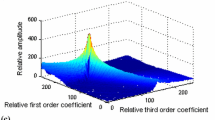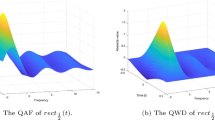Abstract
The fourth-order complex-lag polynomial Wigner–Ville distribution (PWVD) is extended to generate a high resolution time–frequency distribution for multicomponent signals in this paper. For signals with polynomial phase up to order four, the interferences between different components are reduced by the convolution in the frequency domain of the complex-lag PWVD. The complex-lag PWVD can achieve optimal energy concentration, and it is used in the inverse synthetic aperture radar (ISAR) imaging of maneuvering targets, where high quality instantaneous ISAR images are obtained. Simulated results demonstrate the effectiveness of the method.
Similar content being viewed by others
References
Z. Bao, C.Y. Sun, M.D. Xing, Time-frequency approaches to ISAR imaging of maneuvering targets and their limitations. IEEE Trans. Aerosp. Electron. Syst. 37(3), 1091–1099 (2001)
B. Barkat, B. Boashash, Design of higher-order polynomial Wigner–Ville distributions. IEEE Trans. Signal Process. 47(9), 2608–2611 (1999)
G.A. Bi, Y.M. Wei, Split-radix algorithms for arbitrary order of polynomial time frequency transform. IEEE Trans. Signal Process. 55(1), 134–141 (2007)
B. Boashash, P. O’shea, Polynomial Wigner–Ville distributions and their relationship to time-varying higher order spectra. IEEE Trans. Signal Process. 42(1), 216–220 (1994)
V.C. Chen, H. Ling, Time–Frequency Transform for Radar Imaging and Signal Analysis (Artech House, Boston, 2002)
H. Choi, W.J. Williams, Improved time–frequency representation of multicomponent signals using exponential kernels. IEEE Trans. Signal Process. 37(6), 862–871 (1989)
I.S. Choi, B.L. Cho, H.T. Kim, ISAR motion compensation using evolutionary adaptive wavelet transform. IEE Proc. Radar Sonar Navig. 150(4), 229–233 (2003)
L. Cohen, Time–frequency distributions—A review. Proc. IEEE 77(7), 941–981 (1989)
J. Cui, W. Wong, S. Mann, Time–frequency analysis of visual evoked potentials using chirplet transform. Electron. Lett. 41(4), 217–218 (2005)
I. Djurovic, T. Thayaparan, L.J. Stankovic, Adaptive local polynomial Fourier transform in ISAR. EURASIP J. Appl. Signal Process., Article ID 36093, 15 pages (2006)
J. Jeong, W.J. Williams, Kernel design for reduced interference distributions. IEEE Trans. Signal Process. 40(2), 402–419 (1992)
K.T. Kim, I.S. Choi, H.T. Kim, Efficient radar target classification using adaptive joint time-frequency processing. IEEE Trans. Antennas Propag. 48(12), 1789–1801 (2000)
A. Monti, C. Medigue, L. Mangin, Instantaneous parameter estimation in cardiovascular time series by harmonic and time–frequency analysis. IEEE Trans. Biomed. Eng. 49(12), 1547–1556 (2002)
M. Morelande, B. Senadji, B. Boashash, Complex-lag polynomial Wigner–Ville distribution, in Proc. IEEE TENCON (1997), pp. 43–46
L.J. Stankovic, A method for improved distribution concentration in the time-frequency analysis of multicomponent signals using the L-Wigner distribution. IEEE Trans. Signal Process. 43(5), 1262–1268 (1995)
L.J. Stankovic, Time-frequency distributions with complex argument. IEEE Trans. Signal Process. 50(3), 475–486 (2002)
L.J. Stankovic, T. Thayaparan, M. Dakovic, Signal decomposition by using the S-method with application to the analysis of HF radar signals in sea-clutter. IEEE Trans. Signal Process. 54(11), 4332–4342 (2006)
T. Thayaparan, S. Kennedy, Detection of a maneuvering air target in sea-clutter using joint time–frequency analysis. IEE Proc. Radar Sonar Navig. 151(1), 19–30 (2004)
T. Thayaparan, G. Lampropoulos, S.K. Wong, E. Riseborough, Application of adaptive joint time-frequency algorithm for focusing distorted ISAR images from simulated and measured radar data. IEE Proc. Radar Sonar Navig. 150(4), 213–220 (2003)
X.B. Wang, X.Y. Zhou, T.J. Cui, High-resolution inverse synthetic aperture radar imaging based on the shooting and bouncing ray method, in IEEE Proceedings of GSMM 2008 (2006), pp. 432–435
Y.X. Zhao, L.E. Atlas, R.J. Marks, The use of cone-shaped kernels for generalized time–frequency representations of nonstationary signals. IEEE Trans. Acoust. Speech Signal Process. 38(7), 1084–1091 (1990)
Author information
Authors and Affiliations
Corresponding author
Rights and permissions
About this article
Cite this article
Wang, Y., Jiang, Y. Fourth-Order Complex-Lag PWVD for Multicomponent Signals with Application in ISAR Imaging of Maneuvering Targets. Circuits Syst Signal Process 29, 449–457 (2010). https://doi.org/10.1007/s00034-010-9154-z
Received:
Revised:
Published:
Issue Date:
DOI: https://doi.org/10.1007/s00034-010-9154-z




